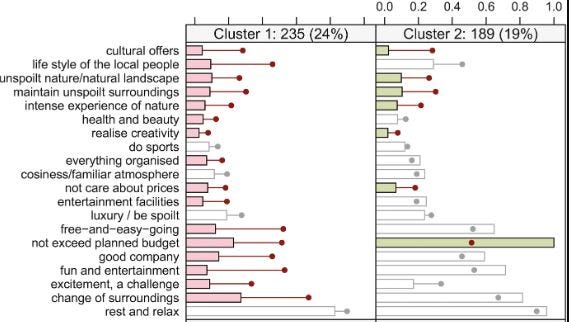
Customer Segmentation as A Strategy
Last Updated on July 26, 2023 by Editorial Team
Author(s): Satsawat Natakarnkitkul
Originally published on Towards AI.
Introduction to the data-driven segmentation and integrate them onto your strategy

What and Why Customer Segmentation
Customer segmentation is
the process of identifying and grouping the customers into naturally existing or artificially created segments of customers based on the certain traits or characteristics they shared.
The ultimate goal of customer segmentation within an organization is to have a strategic level of understanding of its customer base. Most of the use cases in customer segmentation will relate to marketing, for example;
- Marketing promotion effectiveness — how our customers interact with our marketing communication, do their purchasing behaviors impact by that promotion, do we miss any customers when pushing promotion
- Product Mix — how our customers interact with our products and services, are they exposed to all or some of our offerings, Are there any opportunities where we can serve more offerings to customers
These are some of the examples for marketing, however, the use cases of customer segmentation can be expanded out of the marketing department like logistics, strategy, and others, to name a few.
For marketing people, why do we still need segmentation when we have segmentation-of-one
This is probably a question for those data scientists or marketing people who have exposure to personalized marketing or recommendation engine because those concepts have already interacted with the one-to-one customer.
The simplest explanation is that customer segmentation is more on the strategy level and segment-of-one (or personalization) is more on the tactic level. At a strategy level, you can imagine you are determined which mountain is the most suitable for you to climb, and at the tactic level, you choose which equipment is best to climb that mountain.

So if I want to start doing segmentation, what data should I use?
For the data-driven approach to customer segmentation, the activity will mainly rely on the data in our segmentation method. Generally, when we define what data to use, we should prepare the data corresponding to the following 5W’s: Who, Where, What, When, and Why.
- Who: Demographical data — this data area is mostly the starting point of every segmentation to provide the basis of the customers’ information, like occupation, age, gender, income, and education level.
- Where: Geographical data — some may consider geography as part of demographical data, but we should analyze it separately. This is due to some businesses having different offerings based on geography (or location) or some business may have a macro-level impact (i.e., COVID-19, laws, and regulations) which results in different behavioral in different regions.
- What and When: Behavioural data — this data area generally defines what customers buy, how many products, how much they have spent, and how often they buy. Some of us will define this as RFM (Recency-Frequency-Monetary) data. However, behavioral data represents the higher level of data, for example, how they interact with online vs. offline channels, do they respond to our marketing campaign, etc. These behavioral data paint the overall picture of how the customers interact with the business.
- Why: Psychographic data — this data area attempt to respond to the “why” behind the customers’ activities with the business. All other data areas are based on facts — customer interaction, purchasing, and profiles. Emotion and feeling are what make the interaction more personal. Psychographic data may include the lifestyle data, values, sentiment, and opinions that make customers purchase or not purchase.
All of these data areas will be the key drivers for your segment result. Hence, if you want to focus on a specific area, make sure that you have those data ready.
And then…
There will be several steps before doing data-driven segmentation like defining the objective of segmentation, analyzing and understanding the data on each data area, and choosing the clustering algorithm.
There are multiple clustering algorithms to choose from and you can find more information in this post. But to recap on each type of algorithm:
- Centroid-based Clustering (i.e., K-mean, K-Prototype)
- Density-based Clustering (i.e., DBSCAN)
- Distribution-based Clustering (i.e., DBCLASD)
- Hierarchical Clustering
The most popular algorithm for customer segmentation is the K-mean algorithm, which is one of the centroid-based clustering families. But again, you should conduct data analysis on your data to understand them and pick the right algorithm based on your data set. You may opt to try the K-mean algorithm for the first iteration and try out multiple algorithms to see how they fit with your data.
How many segments should I produce?
This is somewhat a million-dollar question for data scientists who are working to create segmentation. Of course, there are many ways to identify the number of segments (I have previously written about this, you can check out this post here to find several techniques to identify the number of segments in the K-mean algorithm).
From experiences, segmentation is the combination of science and art. You can use science to find the number of segments (scree plot, silhouette score, to name a few) but sometimes you need to find the proper number of segments for your business to work with.
One of the plots that I would recommend is Segment Level Stability Across Solution (or, segment-level movement).

With this plot, you can visualize how the population from each segment moves into different segments if we assign different numbers of segments to the algorithm. Now you can zoom into each segment, and find their unique characteristics and what factors drive the movement to another segment (for example; when K changes from 7 to 8, segment 1 has been separated into 2 completely segments). Match them with your strength and focus on your business to properly choose the right segment numbers for you.
Characteristics of good customer segmentation
You start to get the segmentation, so what are the characteristics or criteria for good customer segmentation.
- Differentiable. Customers within the same segment should have similar characteristics (homogeneous) and need to be clearly different from other segments (heterogeneous).
- Substantial. The segment size should be large enough or suitable enough for your business to serve and generate revenue from those to be cost-effective.
- Identifiable. The customers in each segment need to be able to identify, track and measure their traits and characteristics (i.e., purchasing behavior).
- Accessible. The customers in each segment should be able to reach the business via communication, and distribution channels. For example, your business may need to have digital marketing tools to connect with younger generation customers, do you have tik-tok or Twitter to reach them.
- Actionable. Your business needs to have products or services for your segments. Sometimes you may need to create new offerings to fit your customer segment, but will this align with your business objective?
Go and get buy-in
Now you have done your segment analysis and finalized the segment results, you need to be able to communicate your segments to management or other business units.
One technique we can use is segment profiling. In this visualization, we will pick key factors (retrieve by using segment ID as a target, then you can build a tree-based model to view the important features) or the factors which are important to your business (i.e., RFM — recency, frequency, and monetary), and visualize them and highlight the key factors which differentiate each segment.

Executives and managers love stories and visualization, we can use the visualization above and summarize them into customer persona. Several benefits of building a customer persona are:
- Provide a key summary and overall understanding of your customer traits, characteristics, and needs.
- Provide a great way of products or services each segment is exposed to and provide the overview of how or what products the business can offer or need further development.
- Prioritize the initiatives, and budget based on the segment sizing and opportunities in each segment
- Single communication of customer segmentation creates alignment across the business (Remember! segmentation is a strategic level).
Building the results into customer personas can provide value and insight to everyone and great way to communicate your analysis and finding of each segment.

Reference
Clustering Algorithms U+007C Clustering in Machine Learning U+007C Google Developers
Let's quickly look at types of clustering algorithms and when you should choose each type. When choosing a clustering…
developers.google.com
Get the Optimal K in K-Means Clustering
Quick tutorial on finding the optimal number of clusters in K-Means clutering
pub.towardsai.net
Market Segmentation Analysis
This book is published open access under a CC BY 4.0 license. This open access book offers something for everyone…
link.springer.com
The 5 Best Guides for Creating a Customer Persona
How well do you know your customers? If you're like most of us, probably not as well as you should. One of the biggest…
www.usertesting.com
Join thousands of data leaders on the AI newsletter. Join over 80,000 subscribers and keep up to date with the latest developments in AI. From research to projects and ideas. If you are building an AI startup, an AI-related product, or a service, we invite you to consider becoming a sponsor.
Published via Towards AI
Take our 90+ lesson From Beginner to Advanced LLM Developer Certification: From choosing a project to deploying a working product this is the most comprehensive and practical LLM course out there!
Towards AI has published Building LLMs for Production—our 470+ page guide to mastering LLMs with practical projects and expert insights!

Discover Your Dream AI Career at Towards AI Jobs
Towards AI has built a jobs board tailored specifically to Machine Learning and Data Science Jobs and Skills. Our software searches for live AI jobs each hour, labels and categorises them and makes them easily searchable. Explore over 40,000 live jobs today with Towards AI Jobs!
Note: Content contains the views of the contributing authors and not Towards AI.














